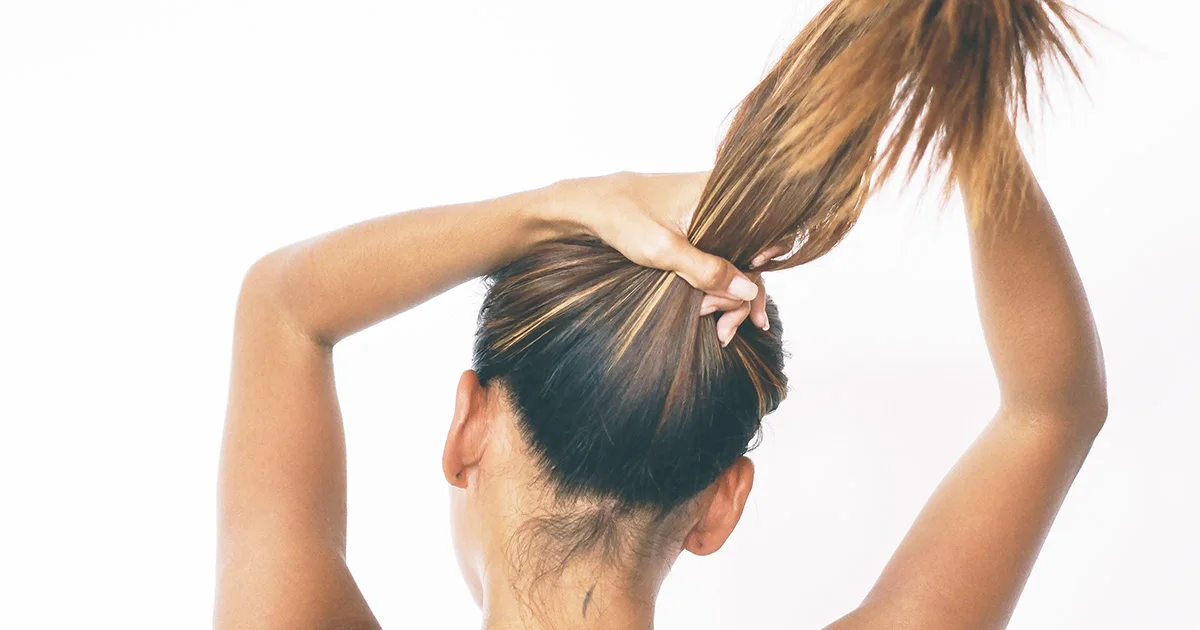Here's what we'll cover
Here's what we'll cover
Hair loss is extremely common, but that doesn’t make it any less distressing. Thankfully, there’s no shortage of treatment options available—some with the goal of stopping hair loss and encouraging hair to regrow, others with the goal of covering it up.
One newer cover-up option you might have heard of is a hair tattoo. Hair tattoos aim to disguise hair loss and have high satisfaction rates (Dhurat, 2017; Park, 2019). Keep reading to learn all about hair tattoos and whether they might be a good option for you.
What is a hair tattoo?
Also known as scalp tattoos or scalp micropigmentation (SMP for short), hair tattoos are a relatively safe option for disguising hair loss. Hair tattoos are similar to traditional skin tattoos and even use similar equipment. A professional tattoos your scalp with thousands of tiny dots—as many as 40,000 in a single session. They often layer the dots and use different pigments of ink to mimic the look of tiny hair follicles. The end result resembles a full head of hair with a short buzz cut (Rassman, 2015; Dhurat, 2017).
In addition to covering up bald spots, hair tattoos can be used in the following situations:
To make the hair look denser in areas of thinning hair, such as a receding hairline or thinning hair around the temples
To cover up scarring from hair transplant surgery or conditions like alopecia areata or scarring alopecia (Seyhan, 2021)
To mask hair loss in people who don’t want to undergo hair transplant surgery, or use topical medications like minoxidil (Rogaine) for treating hair loss (Rassman, 2015)
From start to finish, the hair tattoo procedure can take different amounts of time, depending on the scope of hair loss. It often takes several treatment sessions to complete a hair tattoo, each taking up to eight hours. Most people go through 2–4 sessions, although it may take as many as seven to get desired results (Rassman, 2015; Park, 2019).
4 benefits of a hairline tattoo
Hairline tattoos are a good option for some people experiencing hair loss. Here’s a quick look at their benefits.
1. Hair tattoos are believable and convincing
Hairline tattoos effectively create the natural look of real hair with a short buzz cut. They can look good whether you have a fully shaved head, small areas of thinning, or a single bald spot (Rassman, 2015). Several studies report very high satisfaction rates among balding men, as high as 100% in some cases (Dhurat, 2017; Park, 2019).
2. They last longer than other hair loss treatments
Hair tattoos can look good for years before needing a refresh, whereas toupees need regular refittings and maintenance (Saed, 2017). Also, most hair loss medications require daily administration; if you stop using them, your hair regrowth will reverse. In one study on hair tattoos, the participants reported minimal fading, and 80% were still very satisfied with their hair tattoo, even after a few years (Seyhan, 2021).
3. The recovery is low-maintenance and quick
Hairline tattoos are less painful than traditional tattoos since the needles only penetrate the very upper dermis of your scalp, as opposed to the deeper skin penetration of traditional tattoos. In addition to being relatively painless, hair tattoos provide near-immediate results with a quick recovery period of two weeks or less (Dhurat, 2017). By comparison, hair transplants can take months to show results and are significantly more invasive (Zito, 2021; Saed, 2017).
4. They’re more affordable than other options
The cost of a hair tattoo varies depending on the extent of hair loss and how many sessions you’ll need. While it is not the most affordable option, it is cheaper over time than more expensive options like undergoing hair transplant surgery (Saed, 2017).
Are there any downsides to hairline tattooing?
Scalp tattoos do have some downsides. If any of the following are dealbreakers for you, you may want to investigate other hair loss solutions (Rassman, 2015; Zito, 2021):
They don’t actually treat hair loss, only the appearance of it. Hair tattoos merely disguise bald spots or thinning hair. Unlike options such as minoxidil, finasteride (Propecia), or hair plugs, hair tattoos do not stop balding or help new hair grow.
They’re not a permanent solution. Hair tattoos are more of a semi-permanent solution to hair loss. You will need to repeat the procedure every handful of years when it begins to fade.
They are time-consuming. It often takes multiple sessions to complete a hair tattoo, and each session can take up to eight hours.
The results are not 100% perfect. While hair tattoos are impressively believable and appear natural from a distance, a person who gets up close will be able to see and feel that it is not a natural hair texture.
Finasteride Important Safety Information: Read more about serious warnings and safety info.
Risks of hair tattoos
Hairline tattooing is best for people with areas of thinning hair or total baldness who are okay with keeping a very short buzz cut appearance. It’s not a good option for people who want longer hair.
Since it’s a newer procedure, there simply hasn’t been enough time to research the long-term safety or side effects of scalp tattoos. To date, researchers have noted some risks, although they are rare. These include a skin infection from contaminated tattoo ink, needles, or packaging, or an allergic reaction to ingredients used in the artificial pigments (Rassman, 2015).
If the pigments contain metals, the tattoo could lead to some pain or swelling during an MRI (magnetic resonance imaging) scan, should you need one in the future. The pigments may also migrate to other areas of the body, such as your lymph nodes, but scientists don’t yet know if that causes any long-term health issues. Finally, tattooing inks are considered cosmetic, so they are not regulated by the US Food and Drug Administration (FDA)—although, even the FDA admits that’s partly because they haven’t found significant safety problems with them (Rassman, 2015).
You can minimize these risks by going to a reputable provider and telling them about any existing health conditions or medications you are taking. And again, side effects seem to be minimal based on available research. In one small study of 22 people, just one person experienced an allergic reaction, and there were no other complications or serious side effects (Seyhan, 2021). In another study, some patients initially experienced swelling and redness, but that was temporary (Dhurat, 2017). Finally, in a study of 80 patients, no one experienced adverse reactions (Park, 2019).
Hair tattoo cost
Hair tattoos can cost a few thousand dollars, depending on the scope of hair loss and the number of sessions needed. If you’re not sure a hairline tattoo is the right option for you, there are many other things you can try. Hair tattoos are one of many hair loss treatment options, including oral and topical medications, hair transplant surgery, toupees, and microneedling for hair loss. Talk to your healthcare provider about the best options for you.
DISCLAIMER
If you have any medical questions or concerns, please talk to your healthcare provider. The articles on Health Guide are underpinned by peer-reviewed research and information drawn from medical societies and governmental agencies. However, they are not a substitute for professional medical advice, diagnosis, or treatment.
Cranwell, W. & Sinclair, R. (2016). Male androgenetic alopecia. In K. R. Feingold (Eds.) et. al. Endotext . Retrieved from https://pubmed.ncbi.nlm.nih.gov/25905192/
Dhurat, R. S., Shanshanwal, S., & Dandale, A. L. (2017). Standardization of SMP procedure and its impact on outcome. Journal of Cutaneous and Aesthetic Surgery, 10 (3), 145–149. doi:10.4103/JCAS.JCAS_116_16. Retrieved from https://pubmed.ncbi.nlm.nih.gov/29403185/
Park, J. H., You, S. H., & Kim, N. (2019). Shaved hair style scalp medical tattooing technique for treatment of advanced male pattern baldness patients. International Journal of Dermatology , 58 (1), 103–107. doi:10.1111/ijd.14295. Retrieved from https://pubmed.ncbi.nlm.nih.gov/30444267/
Rassman, W. R., Pak, J. P., Kim, J., & Estrin, N. F. (2015). Scalp micropigmentation: a concealer for hair and scalp deformities. The Journal of Clinical and Aesthetic Dermatology , 8 (3), 35–42. Retrieved from https://pubmed.ncbi.nlm.nih.gov/25852813/
Saed, S., Ibrahim, O., & Bergfeld, W. F. (2017). Hair camouflage: A comprehensive review. International Journal of Women's Dermatology , 3 (1 Suppl), S75–S80. doi:10.1016/j.ijwd.2017.02.016. Retrieved from https://pubmed.ncbi.nlm.nih.gov/28492045/
Seyhan, T. & Kapi, E. (2021). Scalp micropigmentation procedure: a useful procedure for hair restoration. The Journal of Craniofacial Surgery , 32 (3), 1049–1053. doi:10.1097/SCS.0000000000007208. Retrieved from https://pubmed.ncbi.nlm.nih.gov/33181616/
Zito, P. M. & Raggio, B. S. (2021). Hair transplantation. StatPearls . Retrieved on Apr. 20, 2022 from https://pubmed.ncbi.nlm.nih.gov/31613520/










